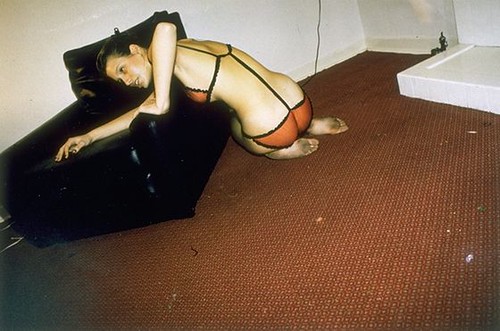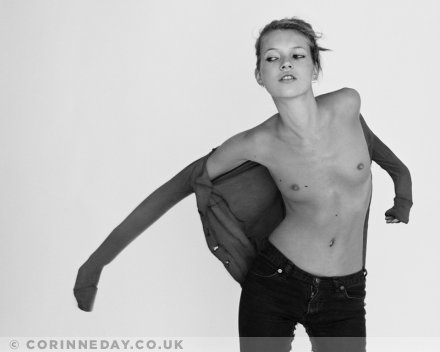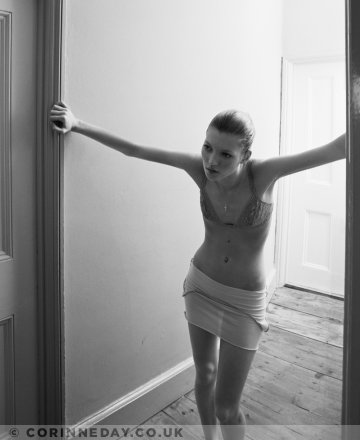So does that mean, to be able to be a Heroin Chic, you have to...?

I think in order to get the "look" you need to be waif-like (of course) but you also need to look ill... dark circles, pale skin, etc. You don't need to do *ahem* to get that way.
So does that mean, to be able to be a Heroin Chic, you have to...?

I think in order to get the "look" you need to be waif-like (of course) but you also need to look ill... dark circles, pale skin, etc. You don't need to do *ahem* to get that way.
I don't see anything heroin chic about those pics...she's quite fresh, joyful and pretty much 'present' judging by her stare.

As a man, I don't find heroin chic attractive. I understand the moods and tones that such pictures set, provoking many people's (mostly women) senses of rebellion, anti-authority, loneliness, sadness, lost, abandonment, anti-luxury, etc.
But I want to understand deeper why all the females viewing and posting on this thread find such aesthetics so appealing? Can some of you elaborate on your own personal allure to such pictures aside from saying "it's gorgeous, beautiful, etc"? Why do they appeal and inspire you? Thanks!






As a man, I don't find heroin chic attractive. I understand the moods and tones that such pictures set, provoking many people's (mostly women) senses of rebellion, anti-authority, loneliness, sadness, lost, abandonment, anti-luxury, etc.
But I want to understand deeper why all the females viewing and posting on this thread find such aesthetics so appealing? Can some of you elaborate on your own personal allure to such pictures aside from saying "it's gorgeous, beautiful, etc"? Why do they appeal and inspire you? Thanks!
^ Completely agree on everything you said!
Did anyone post the Kate Moss by Corinne Day ones?
I've looked through the thread without seeing them, but sorry if they were already posted
pictures from tig-fashion.blogspot.com
picture from saganendalausa.blogspot.com
pictures from corinneday.co.uk
source: http://www.nytimes.com/1996/05/07/s...he-decadent-look.html?pagewanted=print&src=pmWhile the 1980's will always be remembered as the decade of fashion's gluttonous downfall, gilt leading to guilt, 90's fashion is shaping up to be about a decadence of an entirely different kind. It may well be remembered as the decade when fashion served as a pusher -- a pusher of what appear to be the best-dressed heroin addicts in history.
Other fashion references have faded away, be they punk, mainline Philadelphia or monastic austerity. The heroin-addict look, evolving from grunge to the waif to its latest manifestation, has had the tenacity in fashion of, well, an addiction.
Despite fashion's habit of moving on once a look goes mainstream, the heroin-addict esthetic is the look that just won't go away. It's on runways and in magazines, most recently featuring messy knotted hair and the clammy skin that William Mullen, the creative director of Details magazine, calls "junkie sweats." It has replaced the outdated model's hauteur, which comes from imposing beauty, with the contemporary vision of detachment.
"Fashion has always perceived boredom as cool," said Tom Ford, the creative director of Gucci. "The goal is to look like you've seen everything, done everything, been everywhere. It's an intimidating look, and the drug thing is a continuation of all that. If you look like you've been out all night, it conjures up all these images in your head."
But, he continued, "I thought the women and men in our campaign may look bored and jaded but they were still striving to look somewhat conventionally beautiful as opposed to used up, worn-out." He added, "It's the used-up worn-out look I'm a little tired of, people embarrassed to be happy or optimistic."
Used up, worn-out and wasted is hard to avoid if you're thumbing through fashion magazines, from the Matsuda advertisement in which the model seems to lack only bruises on the inside of her arms to Miu-Miu's use of Chloe Sevigny from "Kids" to spread its fashion message.
In March 1994, Vogue reacted to druglike MTV videos and an avalanche of shoots (rejected) by edgy photographers of wan models with a strong article titled "Under the Influence," by Charles Gandee. The article asked, "Who's pushing drug chic, and why?" -- and found the answer: almost everyone.
The genesis of the current look is mostly from British stylists and photographers like Corrine Day, David Sims, and Craig McDean. Mr. McDean shot the most recent Jil Sander campaign and catalogue, where the model Guinevere van Seenus has messy knotted hair, clammy skin, red-rimmed eyes and, in one picture, the left sleeve of her sweater pushed up.
Ms. Sander's catalogue is fascinating because the images seem so counter to her role as the high-power working-woman's designer of choice. She explained that the photography represents a dichotomy she strives for, a fragile model versus sharply cut, aggressive clothes.
"This is really the difficulty of a transitional time," she said. "It always takes some time for people to understand a new way. Before this, every luxe vision came from the couture houses in Paris and women thought, 'I'm elegant if I wear this.' There is a generational change. We want to dress women in a way so they feel modern. I don't want them to look retro or 80's luxe -- I'm totally against it. It's too easy."
The look accentuating pale translucent skin and pores, Ms. Sanders continued, is not related to drugs but to reality, counter to the 80's matte makeup look. "This makeup has nothing to do with the drug scene," she said. "It has something to do with sensitivity and refinement, and going away from the old fashion world. We are not in the old time. Sometimes you have to punch harder to go forward. We can't go back to the old idea of beauty."
What will change before the look does, fashion insiders contend, is the reference point.
"At this point people may be immune to it to a certain extent," said Simon Doonan, the creative director of Barneys New York. "What had the druggy frisson may not anymore, because people have habituated to those type of images. That's what fashion photography has become."
It's true that one of the pioneers of the look, Steven Meisel, told Mr. Gandee, an associate editor at Vogue, that the references were not drug related. Fashion is, to use a rehab word, in denial.
"Just say no," Mr. Mullen said. "It's wrong to say drugs are good. What they want to see in these images is all the other stuff: the glamour, the free sexuality, that whole nocturnal thing that only drugs can truly give you. Only people on drugs stay up all night, but that doesn't mean you can't appreciate the look of someone who stays up all night.
"Two years ago, the druggy esthetic was limited to the really downbeat Courtney Love-inspired shoots. Now they do rich junkies. Fashion has glommed onto it because it's a taboo."
Because it's taboo, erasing the association with drugs may not be as easy as publishing a few thousand fashion photographs, especially with a new wave of heroin references coming to a theater near you. The Miramax movie "Trainspotting," about heroin addicts, is sure to be influential on fashion, which is always looking for a new hip reference. Designers have already used the Iggy Pop-Lou Reed-peppered soundtrack for shows. And "Rent," now on Broadway, is likely to bring Lower East Side style to the forefront again.
Among the runway shows most powerfully resonant of the look was Donatella Versace's Versus. "I don't think they look like heroin addicts," Ms. Versace said. "To me they look like a young girl on the street now. It's not about drugs; it's about an attitude. Girls don't need a lot of makeup or a hairdo to feel good about themselves.
"When I do the fittings with the new girls and see how they arrive in the show, how they talk, how they move, I don't want to put on strong makeup. I want them to be themselves. I respect the way they look in real life rather than change them into something else."
She admits the look is extreme, however. "We've been to the extreme part and it's going to evolve, it's going to be a bit up again," she said. "In underground movies and underground culture around the world young people have a look, and this is the look they have."
When it appears in avant-garde magazine editorials, it is also being touted as realistic. "What you're calling a heroin look we're calling a real look," said Riley John-Donnell, the co-publisher and creative director of Surface, a San Francisco culture magazine with several shoots featuring the look. "Clammy and sweaty is what someone can look like in their apartment in New York. A lot of these images are domestic, sitting in apartments, sitting on couches. It makes fashion more accessible."
As realistic as it may be, it has never been proven that accessibility sells clothes; it is assumed that normally, aspirations do.
"The Bloomingdale's customer does not relate to that runway look," said Kal Ruttenstein, the store's fashion director. "The look of the girls does not stimulate anyone to buy anything."
Mr. Gandee, for one, doesn't expect it to disappear anytime soon.
"It's been around from Rimbaud and Baudelaire to Jim Morrison," he said. "It's just, does it surface or does it remain below the surface? It's always someplace, on MTV or in the East Village. But it's not always in the pages of French Glamour on Christy Turlington with photographs from Mario Testino. It's a long way from Tompkins Square to Paris."

